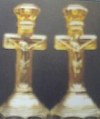Millersburg Carnival Stems
MILLERSBURG STEMS
This endeavor is to familiarize you with the overall beauty of eight distinct compotes and the famous Hobstar and Feather Giant Rose bowl from the company who created some of the most gorgeous crystal known, before they launched into the creation of carnival glass. In business for less than four years, their endeavors were monumental in terms of innovation. From crystal in 1909 to satin finish carnival glass in 1910 and on to radium treatment in such a short time span! Results are remarkable when considering the quantity produced in relation to the output of other leading competitors of that day. John Fenton was indeed “a forward thinker”, instructing workers in the Millersburg, Ohio facility to create “one-of-a-kind” “samples” for him to make judgement upon. His decision to place into production or shelve a color or shape only after examination of an actual object, usurped valuable time and resources. That is the sort of experimentation which may have brought about the financial tailspin of that company in 1911. By May of 1912, the factory was idled for lack of new interest and investors.
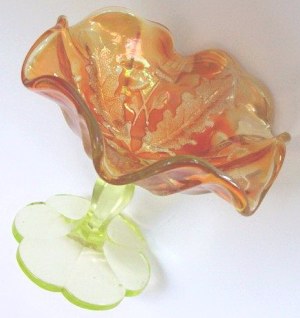 |
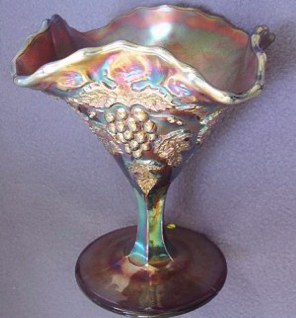 |
|
ACORN
The cloverleaf style base creates added interest to this already distinguished compote. A little under 6” in height, it has a ruffled or jelly type bowl. The pattern is unique to this shape, should be considered very rare in the known colors of amethyst, green, two known vaseline examples, with a third reported. Only one compote is known in marigold. This is a highly desirable compote, and one to watch for in your searches. Millersburg vaseline has a yellow appearance, and will glow under black light. The Wide Panel exterior is used on these pieces.
|
 |
DEEP GRAPE
Standing 7” tall with a top opening of 5” to 7” in either the round or square shape, typical colors known are amethyst, green, or marigold in carnival. One example is known in blue carnival. An amethyst compote is known to have a candy ribbon edge (CRE). A green Deep Grape rose bowl is 7 1/8” high, having a 3 ¾” top opening. This supreme rarity sold in 1991 for $7000, last seen having a crack in the stem. Interior of these pieces is smooth and nicely iridized.
|
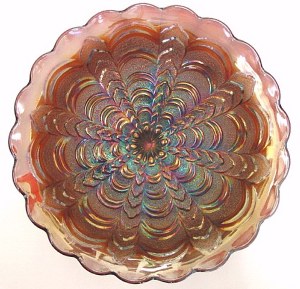 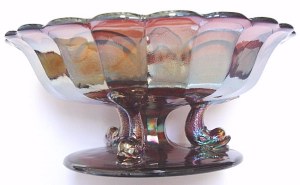 |
The creativity of John Fenton shines through with this entirely different design for the compote shape! Outstanding workmanship is exemplified by its larger diameter bowl supported by three dolphins and a center stem, anchored to a broad support base. The familiar Rosalind interior pattern is used. Colors are amethyst, blue, and green carnival. Some are damaged. Can you imagine the difficulty in removing the extremities from their moulds? Damage never seems to deter buyers when one of these surfaces. They are SO scarce! Wouldn't it be exciting to be the first person to locate a marigold example in this prettiest of compotes?
|
|
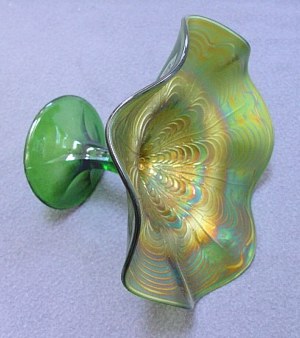 |
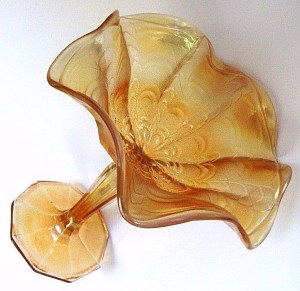 |
|
ROSALIND VARIANT
Listing this stem among Millersburg compotes may be intolerable for some. However, in deference to our longtime friend and colleague, who performed EXTENSIVE research into the matter over many years before his passing in 1998; the eminent Robert Gallo became emphatic in his conclusion that indeed this is a product of Millersburg passion! The exterior of the bowl is smooth. Though you will not find it among the listings given in the book by Marie McGee, on the Millersburg subject, we feel convinced that Bob Gallo's efforts toward identification should be recognized here and now. Each of us has a right to state an educated opinion. Amethyst and green are the known colors. The Peacock Tail design on the Fenton compotes is somewhat similar, yet the Rosalind Vt. design carries a panel, resembling a “feather”, which alternates between the rows or panels of peacock tail, not found on the Fenton compotes. A marigold example would be nice to see.
|
 |
ROSALIND
These compotes are found in two sizes. The 6” version known in amethyst and green are extremely rare. The larger one, shown here, is 9” tall, with one example known in amethyst, being a jelly compote with round bowl. The two marigold compotes are somewhat different. One has a round, slightly flared bowl 4” deep and 6” in diameter. It has a pastel marigold/clear stem and base. This example sold in the fall of '02 for $4000. The illustrated compote has an open, ruffled bowl, showing the pattern nicely. As you can see, it has deeper marigold color which extends down the stem to include the base. One also exists in blue, found in CA in recent years. (These have the Wide Panel back).
|
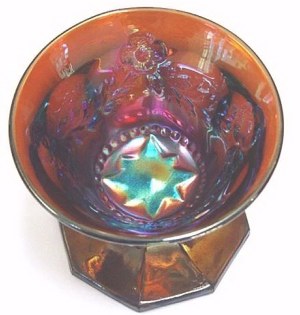 |
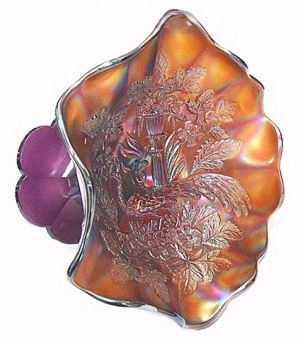 |
|
OLYMPIC
Three inches tall with a bowl diameter of 3”, this miniature compote is from the same mould as the Leaf and Little Flowers compote. Stars are a specialty in Millersburg patterns, but the one brilliant star-like center on this piece is unique to the shape. The circle of beads surrounding the star creates emphasis. A floral wreath encircles the center design, extending up the sides of the bowl. The eight smooth panels used on the exterior are a contrast to the octagon-shaped base. The only known amethyst compote in this design has been in the same collection since 1998. The only known green Olympic was sold to its current owners in 1982. This is one of the top rarities in all of Millersburg glass. None in marigold are known.
|
 |
PEACOCK and URN
Standing 7” high with a bowl diameter of approx. 9”, there can be no doubt that this IS a giant compote. The bowl is 5” deep with a flared, ruffled top. Some are more flared or “open” across the top. This pattern has the bee and three rows of beading on the urn. On all of these, the peacock's tiara (projections from atop the head) turns forward. A design of flowers, with a flower over the leaves on each side of the urn lends compatible surroundings for the bird. A beautiful stem attaches to a cloverleaf base, enhancing the overall effect. This compote is a real treasure in a collection, no matter the color chosen. Amethyst, green and marigold exist, with marigold most difficult to find. Amethyst is most often found and will bring a higher market price. A rumored blue one over the years has never been verified. (Wide Panel exterior used on these.)
|
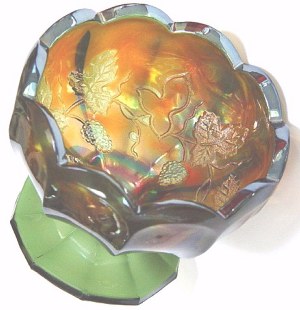 |
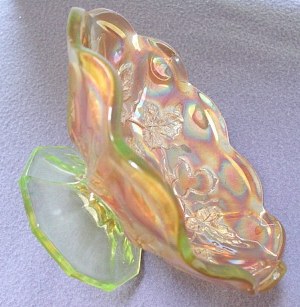 |
|
STRAWBERRY WREATH
(Absentee Leaf)---3 ¼” tall x 4 ¼”, this green example is the “blank”, meaning no alteration of shape with apple wood paddle took place upon removal from the mould. Unruffled, if you will. The sides remain straight up. One each in this blank shape are known in green and marigold, having the “unfinished” leaf.
|
 |
STRAWBERRY WREATH
(Absentee Leaf)---3 ¼” tall with a bowl of 6 1/4” in diameter, the example pictured here is nearly tri-corner in shape; (back pattern is Wide Panel). One leaf has no stippling inside the outline, said to be “unfinished” or “blank”. There are examples such as this in amethyst, green and vaseline. These three examples could be termed “experimental.” Production compotes in this pattern all have “completely stippled leaves” and are found in amethyst/lavender, green, and marigold.
|
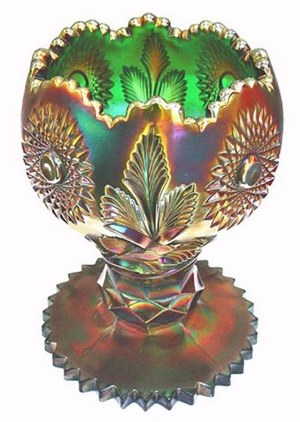 |
HOBSTAR and FEATHER
Giant Rose bowl
Couldn't resist placing this beauty among the stems! It commands much attention when it makes an appearance and well it should! A massive piece such as this, weighing in at six pounds, standing 9” tall, having a 7” cupped, flower-shaped bowl with a turned -in scalloped top, makes a fascinating statement. On the bottom of the stem base, you will find a large hobstar. Carnival Glass colors include amethyst, green and, rarest of all, marigold. In our memory, the most unusual sighting of one of these in either amethyst or green, was on a visit to some prominent Houston, Texas collectors, where sitting on the dining room table for all to see, this giant was completely filled with golf balls!! Amazing !
|
|
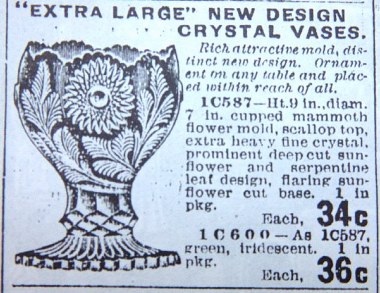 BUTLER BROTHERS WHOLESALE CATALOG ad placed in the April 1911 issue.
|
giant Rose bowl
as it appeared in a BUTLER BROTHERS WHOLESALE CATALOG ad placed in the April 1911 issue. Are you curious about how many were sold in “green iridescent”, as a result of this marketing effort? Apparently, not many, even at 36 cents ea., for so few are known to exist today! As you can determine from reading the ad: this design was carried over from crystal production where it must have been a good seller! Most of us would be happy with “just green” at such a bargain price. IMAGINE! Only two cents more for an iridized example ??? A comparison study of the price differential in those two today, might produce surprising results!
|
|
Dean & Diane Fry….9/03
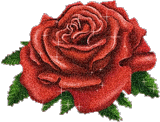






Should you care to contact the Frys, their email address is:
Search Our Sites
back to Carnival Glass 101
Our other sites you may enjoy:
Everything you EVER wanted to know about Indiana Glass
Great Reference for Newer Carnival Glass.
Complete Glassware Catalogs Available to Download
Questions? Comments? Suggestions? Broken Links? Corrections?
Your Friendly Webmaster is here to help!
